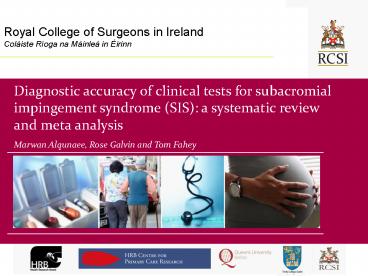Royal College of Surgeons in Ireland Col - PowerPoint PPT Presentation
Title:
Royal College of Surgeons in Ireland Col
Description:
Royal College of Surgeons in Ireland Col iste R oga na M inle in irinn Diagnostic accuracy of clinical tests for subacromial impingement syndrome (SIS): a ... – PowerPoint PPT presentation
Number of Views:70
Avg rating:3.0/5.0
Title: Royal College of Surgeons in Ireland Col
1
Royal College of Surgeons in IrelandColáiste
Ríoga na Máinleá in Éirinn
Diagnostic accuracy of clinical tests for
subacromial impingement syndrome (SIS) a
systematic review and meta analysis Marwan
Alqunaee, Rose Galvin and Tom Fahey
2
Outline
- Background and study aims
- Methods
- Results
- Clinical implications and discussion
- Limitation
3
Background
- Shoulder pain is the third most common
musculoskeletal consultation in primary care - Subacromial impingement syndrome (SIS) is the
most frequent cause of shoulder pain - SIS is a clinical syndrome that indicates pain
and pathology relating to the subacromial bursa
and rotator cuff tendons within the subacromial
space
4
(No Transcript)
5
Clinical test Description End point sign
Neers sign The examiner stabilizes the scapula and asks the patient to forward flex the arm until he reports pain or until full elevation is reached. Pain
Hawkins-Kennedy test The examiner places the arm in a 90 of forward flexion and then gently internally rotates the arm. The end point for internal rotation is either when the patient feels pain or when the rotation of the scapula is felt or observed by the examiner. The test is positive when the patient experience pain during the maneuver. Pain
Empty can test (supraspinatus) The examiner asks the patient to elevate and internally rotate the arm with thumbs pointing downwards in the scapular plane. The elbow should be fully extended. In this position the examiner applies downward pressure on the upper surface of the arm. Weakness
Drop arm sign The patient fully elevates the arm and then slowly reverses the motion in the same arc. If the arm is dropped suddenly or the patient has severe pain the test is considered to be positive. Pain or weakness
Lift off test The patient internally rotates the shoulder placing the hand on the ipsilateral buttock. He is then asked to lift the hand off the buttock against resistance. A tear in the subscapularis muscle produces weakness of this action. Weakness
6
Aim
- Perform a systematic review and meta-analysis to
determine the diagnostic accuracy of five common
clinical tests to detect SIS
7
Methods
- PRISMA guidelines
- Inclusion criteria
- Study design prospective or retrospective cohort
or cross sectional studies - Patient population patients (gt16 years of age)
with a painful shoulder - Explanatory variables any of the five clinical
tests reported in the study - Setting of care inpatient and outpatient
settings - Reference standard arthroscopy or open surgery
8
Methods
- Data extraction
- Data synthesis and analysis
- Statistical software STATA version 10.1 metandi
commands - Bivariate random effects model - summary
estimates of sensitivity and specificity and
their corresponding 95 confidence intervals - Quality assessment
- Quality of Diagnostic Accuracy Tool (QUADAS)
9
Results
10
Results Rule out tests
Clinical test No. of Studies No. of patients Pooled sensitivity (95 CI) Pooled Specificity (95 CI)
Hawkins Kennedy test 6 1029 0.74 (0.57-0.85) 0.57 (0.46-0.67)
Neers sign 5 1127 0.78 (0.68-0.87) 0.58 (0.47-0.68)
Empty can test 6 695 0.69 (0.54-0.81) 0.62 (0.38-0.81)
Drop arm test 5 1213 0.21 (0.14-0.30) 0.92 (0.86-0.96)
Lift off test 4 267 0.42 (0.19-0.69) 0.97 (0.79-1.00)
11
Results Rule in tests
Clinical test No. of Studies No. of patients Pooled sensitivity (95 CI) Pooled Specificity (95 CI)
Hawkins Kennedy test 6 1029 0.74 (0.57-0.85) 0.57 (0.46-0.67)
Neers sign 5 1127 0.78 (0.68-0.87) 0.58 (0.47-0.68)
Empty can test 6 695 0.69 (0.54-0.81) 0.62 (0.38-0.81)
Drop arm test 5 1213 0.21 (0.14-0.30) 0.92 (0.86-0.96)
Lift off test 4 267 0.42 (0.19-0.69) 0.97 (0.79-1.00)
12
Clinical implications
- Lift off test provides strongest evidence to rule
in SIS. - Management of severity of SIS physiotherapy or
surgery - Other predictors of SIS signs and symptoms
13
Discussion
- Five clinical tests suggestive of SIS have modest
diagnostic discriminative value when assessed
against the surgical reference standard - The Hawkins-Kennedy, Neers test as well as the
empty can test are more likely to rule out SIS
when the clinical test result is negative - The drop-arm test and the lift-off test are more
likely to rule in SIS
14
Limitations
- Setting of care
- Reference standard
- Severity of SIS and subjective nature of tests
- Methodological quality

